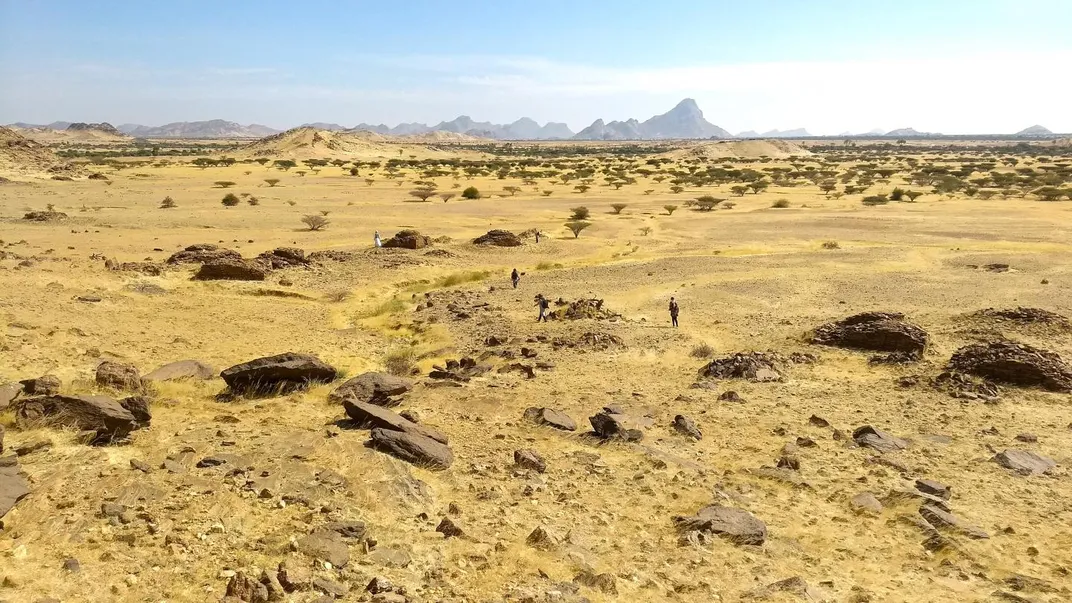These Medieval Islamic Tombs in Sudan Were Laid Out Like Galaxies
Some of the burials appear to be clustered around “parent” funerary mounds of seeming cultural significance
:focal(1103x471:1104x472)/https://tf-cmsv2-smithsonianmag-media.s3.amazonaws.com/filer/54/a9/54a97480-5a9e-449b-b9d1-ab0d3a929026/journalpone0253511g003.png)
Archaeologists in eastern Sudan have discovered thousands of medieval Islamic tombs arranged in patterns resembling galaxies, with burials seemingly clustered around central “parent” tombs of great significance.
As Owen Jarus reports for Live Science, experts uncovered the funerary monuments in the state of Kassala. Per a statement, the international research team drew on satellite images and fieldwork to identify more than 10,000 tombs spanning 1,600 square miles. The findings are newly published in the journal PLOS One.
“To the naked eye, it was clear that the clustered tombs were conditioned by the environment, but deeper meaning may have been implied in their spatial arrangement," lead author Stefano Costanzo, an archaeologist at the University of Naples “L’Orientale,” tells Live Science.
Costanzo and his colleagues used the Neyman-Scott Cluster process—a model initially developed to study the spatial patterns of stars and galaxies—to analyze the burials and pinpoint their locations. Types of tombs recorded included “visually striking” qubbas, whose history and architectural design are the subject of debate, and stone tumuli, which are “relatively simple raised structures, widespread throughout African prehistory and history,” according to the study.

The analysis revealed six clusters with sub-groups of burials nested within, reports the Jerusalem Post. As Becky Ferreira explains for Vice, the researchers suggest that the parent tombs, which “are akin to galactic centers,” are older burials of cultural significance, “with younger tombs radiating away from them, like the stars in a galactic [disc].”
These older, larger burials tend to be concentrated in “favorable locations with readily available construction material,” notes the study.
Per the Post, the seminomadic Beja people probably created the cemeteries as tribal or family graveyards. As Vice points out, the Beja have inhabited the area for at least 2,000 years, though other groups settled in the area before them.
Researchers hope the discovery will shed light on the group’s history: Most modern scholars, says Giovanni Ruffini, a historian at Fairfield University who was not involved in the study, to Live Science, have had to draw “on scattered references in literary texts to write Beja history, and the results just aren’t satisfying.”
Far from being randomly situated across the Sudanese landscape, the burial mounds’ placement was probably influenced by both geological and social factors, according to the statement.
/https://tf-cmsv2-smithsonianmag-media.s3.amazonaws.com/filer/2f/79/2f79d567-2b42-4ba8-8191-d784759f6776/journalpone0253511g002.png)
Speaking with Vice, study co-author Habab Idriss Ahmed, an archaeologist at the Sudanese National Corporation for Antiquities and Museums who directed the team’s fieldwork, says, “This kind of study can add a lot of information for us as archaeologists. It gives us a lot of information in terms of the vast area that these funerary monuments extended.”
Local archaeologists, sometimes working in tandem with scholars further afield, have long studied Kassala—but as Vice notes, the region’s lack of infrastructure and remote location mean its cultural history has yet to be fully unearthed.
“I think that eastern Sudan, as a whole, deserves more recognition in an official way, not just in a sense of protecting … sites from gold-mining and the gold rush with guardians, but maybe even to be listed as an official heritage site,” Costanzo tells Vice. “That would be a very, very big outcome for this kind of research.”
Outside of the newly documented burial mounds, Sudan is home to a wellspring of archaeological riches, including funerary monuments and remnants of ancient Nile Valley civilizations. The city of Meroe, for instance, is home to stunning, millennia-old pyramids standing upward of 100 feet tall.
And, earlier this year, a separate team of researchers unearthed an enormous medieval cathedral in northern Sudan. Part of Makuria, a “fairy tale [Nubian] kingdom” that has since been largely forgotten, the church likely served as a seat of Christian power some 1,000 years ago, archaeologist Arthur Obluski tells Atlas Obscura’s Matthew Taub.
The scholar adds that the kingdom “stopped advances of Islam in Africa for several hundred years,” even while Muslims “conquered half of the Byzantine Empire.”
/https://tf-cmsv2-smithsonianmag-media.s3.amazonaws.com/accounts/headshot/Isis_Davis-Marks_thumbnail.png)
/https://tf-cmsv2-smithsonianmag-media.s3.amazonaws.com/accounts/headshot/Isis_Davis-Marks_thumbnail.png)